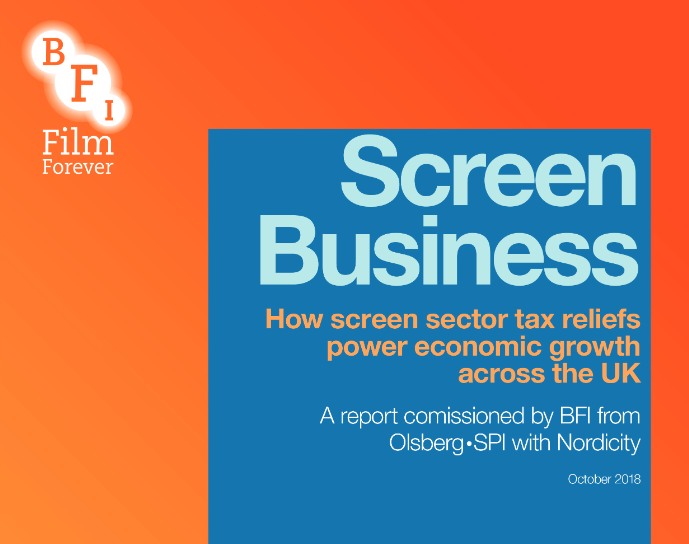An independent new report published today demonstrates the huge value of the government tax reliefs across the UK’s screen industries, seeding unprecedented levels of production, creating thousands of jobs, growing businesses and infrastructure, generating record levels of inward investment, boosting exports of UK productions and services internationally and creating spillover benefits for other industries.

The report reveals that an estimated £632 million in tax relief seeded £3.16 billion in direct production spend in 2016, a 17% increase on 2015. UK-made productions generated £7.9 billion as the screen sector’s overall economic contribution (GVA), including £2 billion in tax revenues. Production spend which would not have taken place without the tax reliefs, known as additionality, was worth £4.1 billion in 2016.
Screen Business: How tax incentives help power economic growth across the UK is a comprehensive analysis of the economic contribution of the tax reliefs for film, high-end television and, for the first time, analyses the new tax reliefs for video games, TV animation programmes and children’s TV programmes. The report uses the latest complete dataset available from 2016.
The report has been produced by analysts Olsberg SPI with Nordicity, and commissioned by the BFI, working with industry partners including the British Film Commission (BFC), Pact, Pinewood Group, UK Interactive (Ukie), the UK Screen Alliance and Animation UK.
“From TV shows like The Crown, to films like Darkest Hour, and animations like Peppa Pig, our creative industries are intrinsic to the rich cultural fabric of the UK. But they’re also an important part of a dynamic and diversified economy, and a key component of our great, global trading nation. That is why this government is committed to supporting our highly-skilled and innovative creative industries through creative sector tax reliefs. I am confident that the creative industries will continue to grow, provide strong employment and be the face of British culture to the world in future years.”
Rt Hon. Philip Hammond MP, Chancellor of the Exchequer
“The UK is a creative powerhouse for producing many award-winning films, shows and video games enjoyed by millions globally. It is home to incredible success stories such as James Bond, Batman Arkham, The Crown and Horrible Histories demonstrating that Britain is a hub for creativity. These fantastic statistics show investment in our screen industries is booming and government is committed to supporting their continued success through our tax reliefs and modern industrial strategy, which is helping our creative sectors go from strength to strength.“
Minister for the Creative Industries, Margot James
“Screens of all sizes are now central to our daily lives and today’s report shows the UK as a global leader in creating the content for those screens. This new report endorses the huge part the government’s tax incentives play in our success story, creating a fiscal environment that’s boosting the economy, creating jobs and supporting our outstanding talent and infrastructure. The reliefs are also of huge cultural importance, enabling talent to produce the richest possible range of films, television programmes and video games, which create IP, and are loved by audiences both at home and around the world. It is the BFI’s mission to maintain and improve this globally competitive environment for the future and the BFI stands ready to work with government and industry to help continue this growth in the years ahead.”
Amanda Nevill, BFI CEO
“Yet again the research shows how much return on investment the creative industries and the screen sector in particular produces for the UK economy. Using the tax relief to maximise opportunities and growth across the UK is vital to help the UK screen sector achieve the high quality needed to compete globally.”
John McVay, Chief Executive of Pact
“Film and high-end TV are big business, and the record-breaking inward investment figures demonstrate outstanding growth and the success of the UK in continuing to meet increasing demand, delivering world-class skills, talent and technical expertise. This fantastic achievement also spans animation and games, seeing the entire screen sector delivering at the highest level throughout the UK’s nations and regions, and translating to economic growth, job creation and training opportunities. It is wonderful to see these figures clearly demonstrating the value of the tax reliefs in reaping incredible dividends for our economy and also for industry in terms of boosting infrastructure and opening up new business opportunities.”
Adrian Wootton, Chief Executive of Film London and the British Film Commission
“The ‘Screen Business’ report proves what an economic, cultural and technological powerhouse the UK games industry is. The video games tax relief is an effective incentive to companies making games with a uniquely British and European flavour and UK-based talent, that otherwise might not have been made. The report is important in showing the return on the investment that the VGTR makes to the economy in employment, and enrichment of our cultural output. The video games tax relief is so important in providing confidence and certainty to the ecosystem we have in the UK and we look forward to its continued influence.”
Dr Jo Twist OBE, CEO Ukie
“The UK’s consistent success in delivering world-class films, television and video games is testament to our creativity, highly skilled workforce, state of the art facilities and fiscal incentives. This report from the BFI provides the evidence needed by business to attract continued private investment in the screen industries and generate further growth. Pinewood’s confidence in the UK as a leading player in this global industry and the opportunities we have for growth underpin our own increased investment in new and expanded production facilities.”
Andrew Smith, Corporate Affairs Director, Pinewood Group
“The consistently high quality of technical innovation achieved by UK film and television crews is unrivalled. Their efficiency and creativity sets the bar for those international executives who only want to work with the world’s best. In this fast moving and highly competitive sector, the UK’s tax reliefs are crucial, enabling the industry to compete successfully in the global marketplace. The government’s ongoing support enables our crews to showcase their skills and talents on an impressive scale. Alongside this, ongoing government support and continuing investment from industry, improves and broadens our skills-base and prepares us well for the future. In this way we shall continue to increase productivity, encourage creativity and create jobs.”
Producer Iain Smith, Applecross Productions (Mad Max: Fury Road, Children of Men), Chair of the British Film Commission, Film Skills Council and the Film Industry Training Board
“The UK’s VFX industry has seen a significant growth as a result of the changes made in 2014 to the qualification threshold for tax relief which has allowed productions to qualify on the basis of VFX work alone. This has brought in more productions across both film and HETV and in recent times the UK’s VFX companies have been able to attract significant work for SVoD platforms.”
Neil Hatton, Chief Executive, UK Screen Alliance
Production spend
Expenditure on feature film production in the UK has doubled in nine years since the film tax relief was introduced, from £849 million in 2007 to a record-breaking £1.72 billion in 2016. High-end television production has also boomed since the introduction of the high-end tax relief in 2013, with expenditure more than doubling over the ensuing three years from £414.9 million to £896.7 million. The video games tax relief which came into effect in 2014 has supported £389.9 million of development expenditure in 2016, up from £228.8 million in 2015. The animation and children’s television tax reliefs have helped these smaller but culturally vital sectors develop ‘greenshoots’ and generate expenditure of £97.1 million and £61.0 million respectively.
Technology has had a seismic impact in driving structural change and innovation in screen production and distribution as well as audience consumption of film, TV and video games.
Growth, jobs, productivity and tax revenues
In 2016, screen production supported by the tax reliefs generated £7.91 billion in GVA for the economy and 137,340 FTEs of employment in the UK. The employment and economic activity generated by screen production supported by the tax reliefs yielded £2.04 billion in tax revenue in 2016. Production activity across the tax relief sectors generated 48,330 direct and indirect FTEs of employment directly in production in 2016.
Over four years the tax reliefs have driven a 63% growth in production spend and a 62% increase in employment across film, high-end television and animation television programmes. The overall tax revenues across film, high-end TV and animation television programmes have grown by 67% from £1.11 billion in 2013 to £1.86 billion in 2016. All screen sector tax reliefs deliver a consistently growing return on investment through GVA.
Film, high-end TV and animation television programmes, the three sectors with the longest established tax reliefs, have grown their overall GVA contribution by 73%, from £4.19 billion in 2013 to £7.30 billion in 2016. Film was the largest contributor, generating £5.23 billion.
The growth in spend and investment within the UK screen infrastructure is stimulating further need for skilled people. The BFI’s £19 million investment plan supported through the National Lottery, announced last year, is addressing the need for 10,000 new entrants to keep the UK in the vanguard of global film production over the next five years.
The rate of productivity (the amount of economic output, GVA, per FTE across the tax relief screen sectors) across the tax relief supported screen sectors at £75,600 per FTE is higher than for the average for UK economy as a whole (£62,144). Video games delivered the highest rate of labour productivity in 2016 at £83,800 and visual effects (VFX) also generated relatively high labour productivity at £81,300.
The tax reliefs play a crucial role supporting the UK’s competitiveness as a creative destination, attracting international inward investment production in the face of strong global competition. They have also helped lead to a repatriation of high-end TV productions which would otherwise have been made outside the UK.
Attracted to the UK’s world-class skills, facilities and diverse locations, film and high-end television production attracted £1.97 billion of inward investment and international co-production in 2016, including projects from the US, Europe and other markets in 2016; 76% of the total spend on film and high-end television production. Inward investment in UK film production reached £1.38 billion in 2016, the highest ever recorded and a 11% increase from £1.24 billion in 2015. High-end TV attracted £554.2 million of inward investment and international co-production expenditure in 2016, a 28% increase on £431.6 million in 2015. The total amount of inward investment and international co-production spend attracted by all five sectors was over £2 billion in 2016.
Tax relief supported production is also fuelling further private sector investment with more than £850 million identified spend on facilities across the UK since 2013 to service the growth in production. New and developing studio spaces include Wolf near Cardiff, Pentland in Scotland, Church Fenton in Yorkshire, Belfast’s Harbour Studios, Dagenham in London, Shepperton Studios, Longcross Studios, Elstree Studios and the Littlewoods building in Liverpool.
The strength of the UK video games sector has attracted over £1.75 billion of inward investment since the introduction of the VGTR, with creative hubs across the UK including Brighton, Cambridge, Cardiff, Guildford, Glasgow, Edinburgh, Dundee, Liverpool, London, Manchester, Oxford, Sheffield, Leeds, Nottingham and Warwick/Leamington Spa.
VFX
For the first time, the impact of the tax reliefs on the Visual Effects (VFX) sector has been analysed. Whilst VFX is not a direct recipient of its own tax relief, it has become a vital and creative element in film and TV production, driving business growth and innovation through UK-based productions such as Star Wars: The Force Awakens, Paddington and Gravity. This success has fuelled significant private investment in VFX facilities establishing the UK as a global leader in delivering award-winning VFX work, in turn attracting further inward investment production, creating jobs and tax revenues. Direct spend on tax relief supported VFX is estimated to have been £275.4 million for 2016, generating £315.1 million in GVA and 6,120 FTEs of employment. This impact increases to £609 million when the impact of VFX content across the screen value chain is included. The impact increases to £773.9 million in GVA when spillover impacts are added.
FILM
Tax relief, spend and jobs
The film tax relief has helped generate significant increases in production expenditure since it was introduced in 2007, growing from £850.9 million in 2007 to a record £1.72 billion in 2016, of which £1.38 billion was inward investment spend. Since 2013, the film tax relief has supported higher-budget films such as Dunkirk and Star Wars, all made in the UK alongside independent UK films such as Paddington 2, Lady Macbeth, Their Finest and God’s Own Country.
In 2016 an estimated £343.6 million of tax relief was claimed against total expenditure in the UK of £1.72 billion. When wider economic impacts – revenues from industries that derive benefits from film production – are taken into account, film contributed a total GVA of £5.23 billion in 2016 including tax revenues of £1.28 billion.
The evidence shows that growth is set to continue. The BFI’s interim film production statistics for 2017 show a new record spend with £2.00 billion, a 12% increase on 2016. Films which went into production in the UK recently included the blockbuster Avengers: Infinity War, Solo: A Star Wars Story, Dumbo, Mission Impossible 6, Aladdin, Yardie, Phantom Thread, The Boy Who Harnessed the Wind and Peterloo.
Film generates substantial employment within the UK. In 2016, film production, on its own, generated 28,250 FTEs of direct employment, across the film value chain contributing £2.46 billion in direct GVA and £619.7 million in direct tax revenues. With all impacts added, tax relief supported film production delivered an estimated 86,800 FTEs and £5.23 billion in GVA.
Distribution revenues
The distribution of UK-made films generated £2.34 billion in turnover across all platforms and £1.40 billion in GVA in 2016. Video platforms – DVD, Blu-ray and online – saw a large increase in the value of UK films with £366.0 million in 2016 from £338.0 million in 2013. Free-to-air and subscription television channels generated £323 million of value for UK films. The cinema exhibition of UK films generated £565.5 million in turnover and £399.9 million in GVA.
International trade and exports
Film is a significant source of export revenues for the UK, generating £1.71 billion and contributing to a trade surplus of £926.0 million in 2016. Film also showed a significantly strongest export-to-GVA ratio of 0.38 compared to the UK’s next best sector of 0.27.
HIGH-END TELEVISION
High-end television (HETV) production in the UK has also boomed since the introduction of the tax relief in 2013. Major shows which have been hits around the world such as Game of Thrones, The Crown, The Night Manager and Black Mirror have shown the UK has the capacity in its infrastructure, services and skills to make large-scale prestige productions, including productions for major online providers such as Netflix and Amazon, which are now investing heavily in original UK content. Netflix has recently announced it may seek to establish a studio base in the UK to service future productions.
Tax relief, spend and jobs
Production spend has almost doubled over the four years since the tax relief was introduced, from £414.9 million in 2013 to £896.7 million in 2016. An estimated £179.4 million of tax relief was claimed against the 2016 expenditure.
High-end TV production expenditure rose by 4.5% in 2016 to a record of £896.7 million (£858.1 million in 2015). Inward investment and co-production has continued to grow, reaching £554.2 million in 2016, a 28.4% increase on £431.6 million in 2015. Further economic impact generated by HETV content boosted its overall GVA contribution to £1.72 billion in 2016, yielding £466.1 million in tax revenues. BFI interim figures for 2017 indicate growing spend on production to £984.6 million.
In addition to the spend and economic impact generated by the production of high-end television projects, the report shows that high-end TV content also generated £580.2 million in revenue for UK broadcasters in 2016, representing 4.2% of the broadcasting sector’s total revenue. High-end TV also generated an estimated £185.8 million in revenue and £62.3 million in GVA for other video platforms, i.e. DVD and Blu-ray sales and rentals, and digital VoD, SVoD and TVoD services.
High-end television production is also a major source of employment for the UK, generating 13,090 direct FTEs throughout all parts of the value chain, rising to 32,660 once spillover impacts are taken into account.
Total economic contribution
When the direct contributions of the core HETV production sector and the value chain and spillover impacts are taken into account, the tax relief raises high-end television’s contribution to 32,660 FTEs, £1.72 billion in GVA and £466.1 million in tax revenues.
TV ANIMATION PROGRAMMES
The UK has a long tradition in creating successful animation programmes such as Peppa Pig, Postman Pat, Bob the Builder, Wallace and Gromit and Thomas and Friends, which have become global franchises generating millions in revenues and long-term intellectual property (IP) value for UK creators. The development, production and market exploitation of animation content is lengthy, with the economic returns from sales and licensing occurring many years after production. However, animation is easily adapted to other languages, a benefit for exports and revenues that can be generated for many years into the future.
Tax relief for animation programmes was introduced in 2013 to support a sector facing strong overseas competition and falling license fees from broadcasters. Although the animation programme sector is smaller than other areas of the screen industries, it is showing ‘greenshoots’ growth.
The tax relief has enabled production expenditure to reach £97.1 million in 2016, generating £100.7 million in direct GVA, £35.7 million in direct tax revenue and 1,550 FTEs of direct employment. This spend on production included £38.3 million in inward investment and co-production. When the impact and growth from across the value chain and spillover benefits is added into the analysis, tax relief supported animation GVA increases to £354.8 million and tax revenues to £107.1 million, delivering 7,120 FTEs of employment.
Despite the size of the sector, it delivers a strong return on investment for the tax relief. In 2016 an estimated £19.4 million of tax relief was claimed against total expenditure in the UK of £97.1 million.
Animation also contributes to other forms of screen content including film, e.g. box office hits The Jungle Book and Shaun the Sheep Movie, and broadcasting, which are incorporated into the spend for productions which access the film and children’s programmes tax reliefs, as well as the UK’s highly successful commercials industry. A survey of UK animation companies suggests that the animation production spend across all sectors increased to £131.5 million in 2016, generating 3,080 FTEs employment and £152.5 million in GVA. This is boosted to £274.1 million in GVA when broadcast value, video and distribution revenues are taken into account.
The UK’s booming screen industries are set against a backdrop of creative success. The UK’s creative industries including the screen sectors were worth almost £92 billion in 2016 and grew by 44.8% from 2010 to 2016, twice the rate of the UK economy – at 22.7% for all sectors. Their contribution to the economy and potential to stimulate further growth has been recognised by the government in its Industrial Strategy which proposes major investments across creative and screen sector developments over the next five years.
Data analysis in the Screen Business report has been conducted in line with HMT ‘Green Book’ methodology and focuses specifically on production activity generated in those sectors supported by tax reliefs, rather than the total value of all. It therefore excludes non-UK content produced, distributed, sold, viewed or exhibited in the UK.
The full report is available at www.bfi.org.uk/screenbusiness








